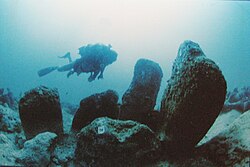Atlit Yam
Human settlement in Israel From Wikipedia, the free encyclopedia
Atlit Yam is a submerged ancient Neolithic village off the coast of Atlit, Israel. It has been carbon-dated as to be between 8,900 and 8,300 years old. Among the features of the 4.0 ha (10-acre) site is a stone circle.
הכפר הנאוליתי בעתלית-ים | |
 Submerged stone structure | |
Location off the coast of Haifa District, Israel | |
| Location | Off the coast of Atlit, Israel |
|---|---|
| Region | Eastern Mediterranean Sea |
| Coordinates | 32°42′38.98″N 34°56′6.54″E |
| Type | Settlement |
| Area | 40 dunams (9.9 acres) |
| History | |
| Founded | 6900 BCE |
| Abandoned | 6300 BCE |
| Periods | Pre-Pottery Neolithic B |
History
Summarize
Perspective
Atlit Yam provides the earliest known evidence for an agro-pastoral-marine subsistence system on the Levantine coast.[1] The site of Atlit Yam has been carbon-dated to be between 8,900 and 8,300 years old (calibrated dates) and belongs to the final Pre-Pottery Neolithic B period. It is currently 8–12 m (25–40 ft) beneath sea level in the Mediterranean Sea, in the Bay of Atlit, at the mouth of the Oren river on the Carmel coast. It covers an area of ca. 40,000 square meters (10 acres).
Underwater excavations have uncovered remnants of rectangular houses and a well. The site was covered by the eustatic rise of sea levels after the end of the last Ice Age. It is assumed that the contemporary coastline was about 1 km (a half-mile) west of the present coast.[2][3] Piles of fish ready for trade or storage have led scientists to conclude that the village was abandoned suddenly. An Italian study led by Maria Pareschi of the Italian National Institute of Geophysics and Volcanology in Pisa indicates that a volcanic collapse of the eastern flank of Mount Etna 8,500 years ago would likely have caused a 10-storey 40 m (130 ft) tsunami to engulf some Mediterranean coastal cities within hours. Some scientists point to the apparent abandonment of Atlit Yam around the same time as further evidence that indeed, such a tsunami did occur.[4][5]
Archaeological findings
Summarize
Perspective

Submerged settlements and shipwrecks have been found on the Carmel coast since 1960, in the wake of large-scale sand quarrying. In 1984, marine archaeologist Ehud Galili spotted ancient remains while surveying the area for shipwrecks.[6] Remains of rectangular houses and hearth-places have been found. Also found was a well that currently lies 10.5 m (34 ft) below sea-level, constructed of dry-stone walling, with a diameter of 1.5 m (4 ft 11 in) and a depth 5.5 m (18 ft) lower. The fill contained flints, artifacts of ground stone and bone, and animal bones in two separate layers. The upper layer contained partly articulated animal bones, which presumably were thrown in after the well went out of use. Other round structures at the site may also be wells. Galili believes that the water in the wells gradually became contaminated with seawater, forcing the inhabitants to abandon their homes.[6]

A stone semicircle, containing seven 600 kg (1,300 lb) megaliths, has been found. The stones have cup marks carved into them and are arranged around a freshwater spring, which suggests that they may have been used for a water ritual.[6][7][8]
Ten flexed burials have been discovered, both inside the houses and in their vicinity. The skeletons of a woman and child, found in 2008, have revealed the earliest known cases of tuberculosis. Bone fish-hooks and piles of fish bones ready for trade or storage point to the importance of marine resources.[6] The men are thought to have dived for seafood, as four skeletons with ear damage have been found, probably caused by diving in cold water.[6] Anthropomorphic stone stelae have been found. The lithics include arrowheads, sickle-blades, and axes.
An excavation was mounted by the University of Haifa on October 1, 1987. A complete human burial, in an excellent state of preservation, was discovered under 10 metres (33 ft) of water on October 4, 1987, with the skeleton oriented in a flexed position and laid on her right side. Subsequent carbon dating of plant material recovered from the burial placed the age of the site at 8000 +/−200 years.
Animal bones and plant remains also have been preserved. Animal bones come mainly from wild species. The plant remains include wild grape, poppy, and caraway seeds. Granary weevils indicate the presence of stored grain. Pollen analysis and the remains of marsh plants indicates the local presence of swamps.
The Homo I skeleton showed traits similar to Natufian populations, but had its own unique morphologic structure, which evidenced inbreeding in the community. The researchers emphasized that one skeleton is not an adequate sample on which to base conclusions. Inland and coastal groups present different types of economical and cultural adaptations to their environment.[9]
Radiocarbon dating
The settlement has been dated by three radiocarbon dates from submerged branches:[citation needed]
References
External links
Wikiwand - on
Seamless Wikipedia browsing. On steroids.

